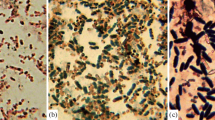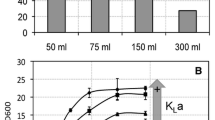Abstract
The accumulation and utilisation of poly-β-hydroxybutyrate (PHB) and extracellular polysaccharide (ECPS) have been studied in Rhizobium NZP 2037 and it was found that PHB synthesis was slow during growth whereas ECPS formation was not affected. PHB synthesis only was dependent on the pH of the medium. PHB and ECPS were both used as carbon sources in the absence of other exogenous carbon. ECPS when given to starved cells as sole carbon source in the absence of nitrogen was used for PHB synthesis by the organism. In the presence of nitrogen ECPS was found to support growth. The extracellular breakdown of ECPS was demonstrated and was accompanied by the release of its constituent glucose. This was favoured by low pH.
Similar content being viewed by others
References
Bailey, R. W.: Loss of ingested plant carbohydrates from the reticulo-rumen. N.Z. J. Agric. Res. 10, 15–32 (1967)
Bailey, R. W., Greenwood, R. M., Craig, A.: Extracellular polysaccharides of Rhizobium strains associated with Lotus species. J. gen. Microbiol. 65, 315–324 (1971)
Becking J. H.: Nitrogen-15 in soil-plant studies, pp. 189–222, Panel Proceedings Series, Vienna: International Atomic Energy Agency 1971
Dawes, E. A., Ribbons, D. W.: Some aspects of the endogenous metabolism of bacteria. Bact. Rev. 28, 126–149 (1964)
Doudoroff, M., Stanier, R. H.: Role of poly-β-hydroxy-butyric acid in the assimilation or organic carbon by bacteria. Nature (Lond.) 183, 1440–1442 (1959)
Duguid, J. P., Wilkinson, J. F.: The influence of cultural conditions on polysaccharide production by Aerobacter aerogenes. J. gen. Microbiol. 9, 174–189 (1953)
Folch, J., Lees, M., Sloane-Stanley, G. H.: A simple method for the isolation and purification of total lipids from animal tissues. J. biol. Chem. 226, 497–509 (1957)
Fottrell, P. F., O'Hara, A.: Multiple forms of d(-)3-hydroxy butyrate dehydrogenase in Rhizobium. J. gen. Microbiol. 57, 287–292 (1969)
Gupta, B. M., Kleczkowska, J.: A study of some mutations in a strain of Rhizobium trifolii. J. gen. Microbiol. 27, 473–476 (1962)
Kilburn, D. A., Taylor, P. M.: Effect of sulphydryl reagents on glucose determination by the glucose oxidase method. Anal. Biochem. 27, 555–558 (1969)
Law, J. H., Slepecky, R. A.: Assay of poly-β-hydroxy butyric acid. J. Bact. 82, 33–36 (1961)
López, R., Becking, J. H.: Polysaccharide production by Beijerinckia and Azotobacter. Microbiol. exp. 21, 53–75 (1968)
McKenzie, H. A., Dawson, R. M. C.: pH, buffers and physiological media. In: Data for biochemical research, pp. 476–508, 2nd Ed., R. M. C. Dawson, D. C. Elliott, W. H. Elliott, K. M. James, Eds. Oxford: Clarendon Press 1972
McRae, R. M., Wilkinson, J. F.: Poly-β-hydroxy-butyrate metabolism in washed suspensions of Bacillus cereus and Bacillus megaterium. J. gen. Microbiol. 19, 210–222 (1958a)
McRae, R. M., Wilkinson, J. F.: The influence of cultural conditions on poly-β-hydroxy-butyrate synthesis in Bacillus megaterium. Proc. roy. Phys. Soc. of Edinb. 27, 73–78 (1958b)
Moustafa, A., Greenwood, R. M.: Esterase and phosphatase isoenzymes in Rhizobia and rhizobial bacteroids in relation to strain effectiveness and proportion of nodule tissue in Lotus. N.Z. J. Sci. 10, 548–555 (1967)
Schlegel, H. G., Gottschalk, G., Von Bartha, R.: Formation and utilisation of poly-β-hydroxy butyric acid by Knallgas bacteria (Hydrogenomonas). Nature (Lond.) 191, 463–465 (1961)
Shuster, C. W., Doudoroff, M.: A cold sensitive d(-)β-hydroxybutyric acid dehydrogenase from Rhodospirillum rubrum. J. biol. Chem. 237, 603–607 (1962)
Sloneker, J. H.: Gas-liquid chromatography of alditol acetates. Methods in carbohydrate chemistry, Vol. 6, pp. 20–24, R. L. Whister, J. N. Be Miller, Eds. New York: Academic Press 1972
Sutherland, I. W.: Advances in microbial physiology, Vol. 8, pp. 143–213, A. H. Rose D. W. Tempest, Eds. London: Academic Press 1972
Vincent, J. M.: A manual for the practical study of root nodule bacteria. In: I.B.P. Handbook, No. 15, p. 3. Oxford: Blackwell 1970
Wong, P. P., Evans, H. J.: Poly-β-hydroxy butyrate utilisation by Soybean (Glycine max Merr.) nodules and assessment of its role in maintenance of nitrogenase activity. Plant Physiol. 47, 750–755 (1971)
Author information
Authors and Affiliations
Rights and permissions
About this article
Cite this article
Patel, J.J., Gerson, T. Formation and utilisation of carbon reserves by Rhizobium . Arch. Microbiol. 101, 211–220 (1974). https://doi.org/10.1007/BF00455939
Received:
Issue Date:
DOI: https://doi.org/10.1007/BF00455939




